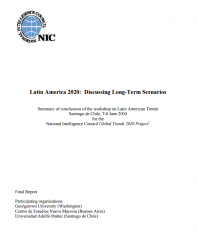
Latin America 2020: Discussing Long-Term Scenarios

The views expressed in this and other papers associated with the NIC 2020 project are those of individual participants. They are posted for discussion purposes only and do not represent the views of the US Government.
Excerpt
As viewed from the early 21st century, the prospects for Latin America in 2020 will be a mixture of lights and shadows. In recent years, Latin America has improved in terms of democratization, some institutional development and a broad consensus on the virtues of financial stability. But the region has also experienced poor social results, inconsistent economic growth, deep loss of legitimacy of its political players, and declining international relevance. At the outset of the new century, the political order of Latin American societies faces new crises.
In fifteen years’ time, Latin Americans will be both more mature and more cautious in terms of democratization and macro-economic policies, but they will struggle with social problems, low institutionalization and recurring governance crises. Few countries will be able to take advantage of opportunities for development, and Latin America as a region will see the gap separating it from the most advanced nations of the planet grow wider. Some situations will improve but always within a cycle of oscillations, progress and setbacks. And those countries and regions that fail to find an economic, political and social direction will be immersed in crises and will experience reversals. All this will take place within the framework of mounting regional heterogeneousness, in which relations with the United States and the quality of domestic democratic governance will mark the great differences among Latin American countries.
This report intends to offer some views on the prospects of Latin America over the next fifteen years. It is divided in two parts. The first part identifies a set of ‘drivers’ (influence factors and agents fostering change and evolution in the region) and studies their meaning within a forward-looking exercise. We find that democratic governance and the quality of institutions; the region’s international insertion—including its relationship with the United States and the main world powers—and the region’s sense of security from new threats are the main, though not the only, factors determining the future of Latin America. In the second part, long-term scenarios and trends for Latin America are outlined based on the abovementioned definitions.
- Issues:
- Demography, Urbanization and Migration, Global and Domestic Governance, Natural Resources, Technological innovation
- Region:
- Latin America
- Year Published:
- 2004
- Institution:
- National Intelligence Council (NIC)

